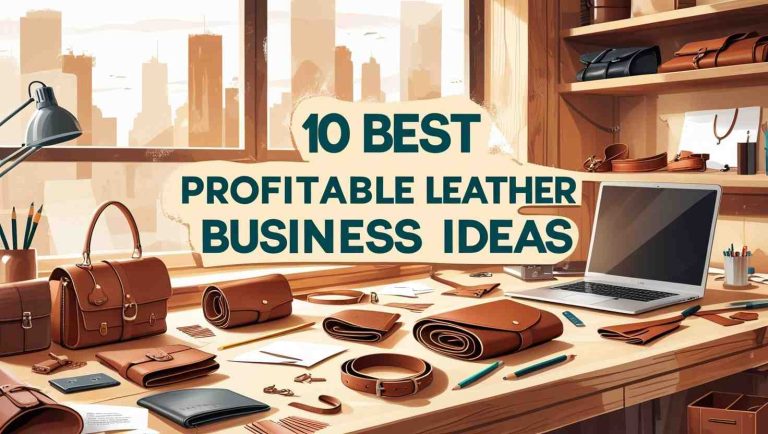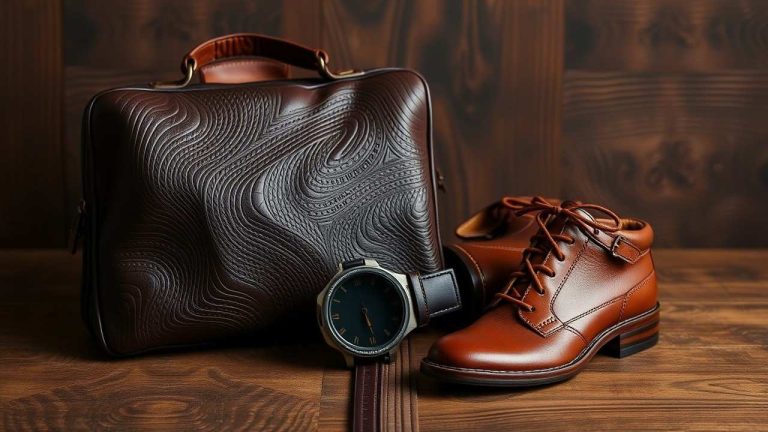There’s something timeless about leather. Whether it’s a sleek wallet tucked into a back pocket, a stylish handbag swung over a shoulder, or a rugged belt cinching a pair of jeans, leather products have an enduring appeal that transcends fashion trends. For aspiring entrepreneurs, starting a leather business can open doors to a world of style, craftsmanship, and serious profits. But how do you start a profitable leather business that stands the test of time? Let’s walk through the journey together — from crafting your vision to building a brand customers love.
Understanding the Leather Industry
The leather industry is a billion-dollar giant, and it’s only growing. According to market research reports, the global leather goods market size was valued at over $400 billion and is projected to keep expanding. Leather touches every corner of the market: luxury handbags, everyday footwear, accessories, jackets, car interiors, even furniture.
Why is leather so lucrative?
- Durability: People pay more for goods that last.
- Luxury Appeal: Leather signifies quality, sophistication, and style.
- Versatility: Leather fits into fashion, utility, decor, and even tech accessories.
Real-world brands like Coach, Hermès, and Saddleback Leather have proven that customers are willing to invest in leather if it speaks of authenticity and craftsmanship.
Benefits of Starting a Leather Business
Before diving into the “how-to,” let’s look at why you should consider it:
- High Profit Margins: A well-made leather wallet costing $30 to produce can sell for $150 or more.
- Creative Freedom: Whether it’s rustic minimalism or high-end glam, you can design your niche.
- Brand Loyalty: Quality leather builds trust, and trust breeds repeat customers.
- Scalability: Start small from your garage or studio and expand into global e-commerce with time.
Is a Leather Business Right for You?
Success in the leather business doesn’t necessarily require decades of crafting experience, but passion, patience, and a strong eye for quality are non-negotiable. Here’s what you’ll need:
- A deep appreciation for craftsmanship
- Basic business management skills
- An interest in design, fashion, or accessories
- Willingness to learn and refine your craft continuously
If this sounds like you, you’re already halfway there.
Step-by-Step Guide on How to Start Leather Business

Define Your Niche and Audience
You can’t sell everything to everyone. Successful leather brands laser-focus on their niche.
Popular Niches in Leather:
- Luxury handbags
- Durable everyday wallets
- Adventure-ready travel bags
- Personalized leather gifts
- Eco-friendly vegan leather products
Research the Market
Study existing brands. Visit local leather shops, check out Etsy, Amazon, and luxury stores. Identify:
- What’s missing?
- What’s trending?
- Who are your competitors?
Use tools like Google Trends, SEMrush, and industry reports for detailed insights.
Create a Business Plan
A leather business without a plan is like a car without a map. Key components:
- Business vision and goals
- Target market analysis
- Budget and financial projections
- Marketing strategy
- Product development timeline
Download a free business plan template if you need a jumpstart.
Choose the Right Leather Products to Sell
Start small with a few signature items. Quality trumps quantity every time. Some beginner-friendly ideas:
- Minimalist wallets
- Slim belts
- Keychains
- Small handbags
- Laptop sleeves
Offer customization options to create uniqueness and higher perceived value.
Sourcing High-Quality Leather
Your material defines your product. Choose suppliers carefully:
| Type of Leather | Ideal For | Characteristics |
| Full-grain Leather | Premium wallets, belts, bags | Durable, ages beautifully |
| Top-grain Leather | Fashion accessories | Smooth, flexible |
| Genuine Leather | Entry-level products | Lower cost, lesser durability |
| Vegan Leather | Eco-conscious market | Animal-free, ethical |
Pro tip: Order small samples first before buying in bulk.
Mastering Leather Craftsmanship
Even if you plan to outsource production eventually, understanding the basics is crucial. Invest in:
- Online courses (Skillshare, Udemy, Tandy Leather)
- Leather crafting books
- Workshops in your city
Essential skills to learn:
- Cutting and pattern making
- Hand stitching and machine sewing
- Burnishing edges
- Dyeing and finishing techniques
Remember, the devil is in the details — uneven stitches or rough edges scream amateur.
Building Your Brand Identity
A brand is more than just a logo. It’s the emotion you evoke. Think about:
- Your brand name: Short, memorable, meaningful
- Your logo: Simple, versatile
- Color scheme and fonts: Consistent across all platforms
- Voice: Luxury and sophisticated? Friendly and adventurous?
Example: Saddleback Leather’s rugged vibe appeals to travelers and adventurers worldwide.
How to Start a Profitable Leather Business Website
Your online store is your digital storefront. Essentials include:
- Professional, clean design
- Easy navigation
- High-quality product photos (consider 360-degree views)
- Strong, compelling product descriptions
- Customer testimonials and reviews
- Secure checkout process
Recommended platforms: Shopify, WooCommerce, Squarespace.
Pricing Your Leather Products Right
Pricing can make or break you. Calculate:
- Cost of materials
- Labor time
- Packaging
- Shipping
- Marketing expenses
- Desired profit margin
Use psychological pricing: $199 feels cheaper than $200. Also, anchor your premium products next to even more expensive options.
Legal and Administrative Basics
- Register your business (LLC, Sole Proprietorship, etc.)
- Trademark your brand name and logo
- Set up business banking and accounting systems
- Get necessary permits (depends on local laws)
Tip: Consult a local attorney familiar with small businesses.
Marketing Your Leather Business
If you build it, they won’t necessarily come. Here’s how you get noticed:
- Social Media: Instagram and Pinterest are gold mines for visual brands.
- Content Marketing: Start a blog sharing leather care tips, style guides, product stories.
- Email Marketing: Build a loyal community with newsletters, sneak peeks, and VIP sales.
- Influencer Collaborations: Gift products to micro-influencers with engaged followings.
Pro Tip: Share behind-the-scenes videos. People LOVE watching how things are made.
Selling Your Leather Products
Where to sell:
- Your website
- Amazon Handmade
- Etsy
- Local boutiques and artisan markets
- Leather fairs and craft exhibitions
Tip: Create beautiful, eco-friendly packaging. The unboxing experience matters more than ever today.
Scaling Your Leather Business
Once orders roll in, it’s time to think bigger:
- Expand your product line (backpacks, jackets, travel gear)
- Hire additional leather artisans or production help
- Collaborate with other brands (limited editions)
- Explore international shipping
- Wholesale your products to boutiques
Scaling is about maintaining quality while increasing quantity. Don’t rush it.
How to Start Leather Business with Sustainability in Mind
Conscious consumers are on the rise. Stand out by:
- Using vegetable-tanned leather
- Minimizing waste
- Offering lifetime warranties for repairs
- Highlighting your commitment to craftsmanship over mass production
Example: Nisolo’s radical transparency has made them a favorite among eco-conscious buyers.
Common Mistakes to Avoid
- Underpricing your goods
- Ignoring branding and storytelling
- Poor quality control
- Neglecting customer feedback
- Expanding too fast, too soon
Learn from others’ mistakes rather than your own.
Conclusion
Starting a profitable leather business is both an art and a science. With passion, craftsmanship, and smart strategy, you can transform raw leather into products that tell a story — and a brand that people proudly wear, gift, and treasure for years. It all begins with the first stitch, the first sketch, and the first brave step toward your dream. So gear up, craft your future, and let your leather legacy begin.


